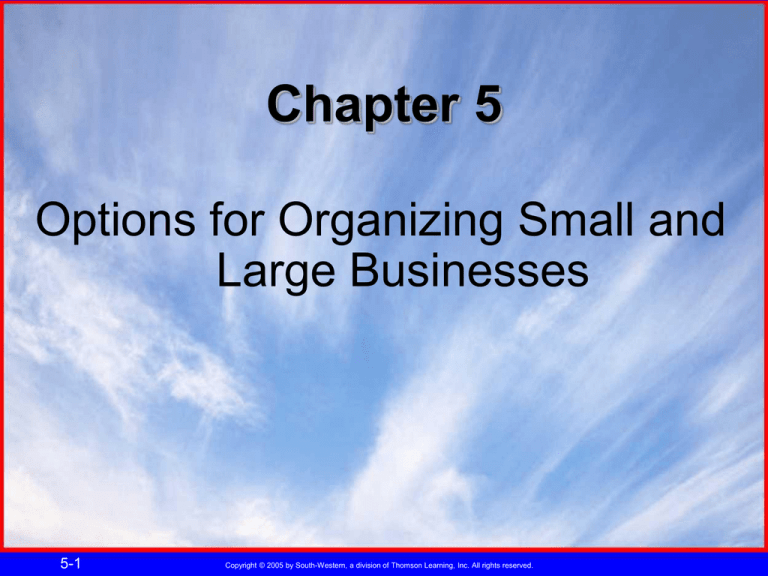
Chapter 5
Options for Organizing Small and
Large Businesses
5-1
Copyright © 2005 by South-Western, a division of Thomson Learning, Inc. All rights reserved.
Most Businesses Are Small Businesses
What is a Small Business?
A firm that is independently owned and
operated, not dominant in its field, and
meets industry-specific size standards for
income or number of employees.
98 percent have fewer than 100 employees
90 percent have fewer than 20 employees
Almost half the sales in U.S. are made by
small businesses
5-2
Copyright © 2005 by South-Western, a division of Thomson Learning, Inc. All rights reserved.
Advantages of Small-Business Ownership
5-3
Copyright © 2005 by South-Western, a division of Thomson Learning, Inc. All rights reserved.
Disadvantages of a Small Business
In addition to being vulnerable to economic
downturns, primary disadvantages include:
Management Shortcomings
Inadequate Financing
Government Regulation
5-4
Copyright © 2005 by South-Western, a division of Thomson Learning, Inc. All rights reserved.
Sources of Small-Business Financing
5-5
Copyright © 2005 by South-Western, a division of Thomson Learning, Inc. All rights reserved.
Increasing the Likelihood of Business Success
Business plan—written document that provides
an orderly statement of a company’s goals, the
methods by which it intends to achieve those
goals, and standards by which it will measure
achievements.
Typically includes following components:
Executive summary
Introduction
Marketing
Financials
Resumes of principles
5-6
Copyright © 2005 by South-Western, a division of Thomson Learning, Inc. All rights reserved.
Increasing the Likelihood of Business Success
Small Business Administration (SBA)
Federal agency that assists small businesses by
providing management training and consulting,
financial advice, and support in securing government
contracts.
Business Incubators
Business incubator—organization that provides
low-cost, shared facilities on a temporary basis
to small start-up ventures
5-7
Copyright © 2005 by South-Western, a division of Thomson Learning, Inc. All rights reserved.
Franchising
Franchising: contractual agreement that specifies
the methods by which a dealer can produce and
market a supplier’s good or service.
Franchisor: owner of the franchise, typically
provides name recognition, building plans, site
selection help, accounting systems, and other
services
Franchisee: small business owner who contracts to
sell the goods or service of the franchisor in
exchange for some payment
5-8
Copyright © 2005 by South-Western, a division of Thomson Learning, Inc. All rights reserved.
The Franchising Alternative
Advantages
Disadvantages
•Recognizable company name
•Expensive franchise fees
and future payments
•A prior performance record
•Business model that has
proven successful
•Tested management program
•Business training
5-9
•The fact that the franchisee
is linked to the reputation
and management of the
franchise
•The potential unsuitability
of the franchisee
Copyright © 2005 by South-Western, a division of Thomson Learning, Inc. All rights reserved.
Alternatives for Organizing a Business
Sole proprietor - owned and
operated by one person.
Partnership - operated by
two or more people who are
co-owners by voluntary legal
agreement.
Corporations - stands as a
legal entity with assets and
liabilities separate from
those of its owner(s).
5-10
Copyright © 2005 by South-Western, a division of Thomson Learning, Inc. All rights reserved.
Comparing the Three Major Forms of Ownership
5-11
Copyright © 2005 by South-Western, a division of Thomson Learning, Inc. All rights reserved.
Alternatives for Organizing a Business
Considerations include:
Personal financial situations and the need
for additional funds
Management skills and limitations
Management styles and capabilities for
working with others
Concerns about exposure to personal
liability
5-12
Copyright © 2005 by South-Western, a division of Thomson Learning, Inc. All rights reserved.
Organizing and Operating a Corporation
Types of Corporations
Domestic—A firm is considered a
domestic corporation in the state where it
is incorporated
Foreign—When company does business
in a state other than the one where it has
filed incorporation papers, it is registered
as a foreign corporation in each of those
states
Alien—A firm incorporated in one nation
that operates in another is known as an
alien corporation where it operates
5-13
Copyright © 2005 by South-Western, a division of Thomson Learning, Inc. All rights reserved.
Organizing and Operating a Corporation
The Incorporation Process
Where to Incorporate
Articles of Incorporation
The Corporate Charter
5-14
Copyright © 2005 by South-Western, a division of Thomson Learning, Inc. All rights reserved.
Organizing and Operating a Corporation
Levels of Management in a Corporation
5-15
Copyright © 2005 by South-Western, a division of Thomson Learning, Inc. All rights reserved.
Stockholder—person or organization who has
bought shares of stock in a corporation.
Closed or Closely Held
Publicly Held
Stock Ownership and Stockholder Rights
Preferred stock owners have limited voting
rights; receive dividends before others
Common stock owners have voting rights but
only residual claims on assets and are the last
to receive any income distributions
5-16
Copyright © 2005 by South-Western, a division of Thomson Learning, Inc. All rights reserved.
When Businesses Join Forces
Acquisition - one firm purchases the property and assumes
the obligations of another.
Merger - combination of two or more firms to form one company.
Horizontal Merger – firms in same industry
Vertical Merger – firms at different levels in production
or marketing process
Conglomerate Merger – unrelated firms
Joint Venture - a partnership between companies formed for
a specific undertaking
5-17
Copyright © 2005 by South-Western, a division of Thomson Learning, Inc. All rights reserved.







